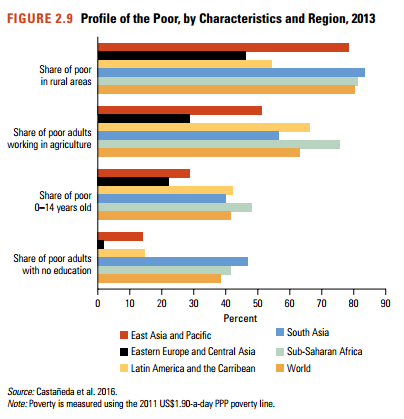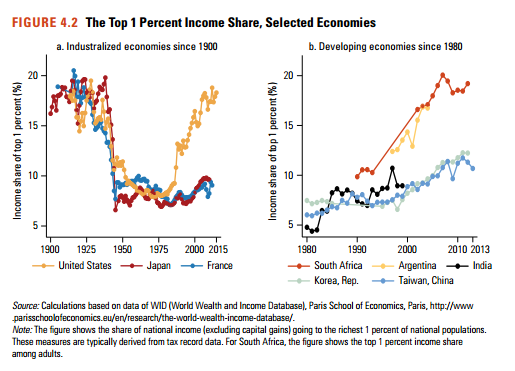But the World Bank thinks more needs to be done to address inequality.
By Dwyer Gunn
(Chart: World Bank)
Earlier this week, the World Bank released its first annual Poverty and Shared Prosperity report on global trends in poverty. First, the good news: In 2013, there were 767 million people, or 10.7 percent of the global population, living in extreme poverty (defined as under $1.90 a day), which represents a decline of 1.7 percentage points (and about 100 million people) from 2012. In fact, global poverty rates have actually been on the decline since 1990 — the World Bank calculates that 1.1 billion people escaped extreme poverty between 1990 and 2013. The chart above illustrates these trends.

(Chart: World Bank)
Most of the recent progress has been driven by improvements in the East Asian, Pacific, and South Asian regions. The majority of the extremely poor now live in sub-Saharan Africa. In general, those living in extreme poverty are overwhelmingly rural, under the age of 14, poorly educated, and employed in the agricultural sector, as the chart to the left illustrates.
The primary focus of the World Bank’s report, however, is on inequality, and the report advocates strongly for a more aggressive approach to combating it. “[T]oday, inequality is constraining national economies and destabilizing global collaboration in ways that put humanity’s most critical achievements and aspirations at risk,” the report reads. “More equal countries tend to have healthier people and be more economically efficient than highly unequal countries. And countries that invest smartly in reducing inequality today are likely to see more prolonged economic growth than those that don’t.”

(Chart: World Bank)
Between-country global inequality has actually fallen since 1990, after over a century of increases. Within-country inequality, such as the type that’s elicited such concern in the United States, is on the rise. The chart to the left illustrates trends in within-country inequality in a number of industrialized and developing countries — note how the U.S. compares to Japan and France.
It’s evident that not every country has followed the path of the U.S. — countries like Japan and France, as well as a number of low- and middle-income countries, have managed to constrain the growth in inequality, or, in some cases, actually reduce inequality. The report specifically focuses on five countries — Brazil, Cambodia, Mali, Peru, and Tanzania — and identifies five shared “building blocks of success”: “prudent macroeconomic policies, strong growth, functioning labor markets, and coherent domestic policies focusing on safety nets, human capital, and infrastructure.”
From a policy perspective, the report calls for programming across a number of areas that the evidence indicates effectively reduce inequality:
- Early childhood development and nutrition (including programs focused on parenting skills, preschool, and breastfeeding and nutrition). Poor children have less access to early childhood education, good nutrition, and adequate health care, and are likely to enter school with big gaps. Time and again, researchers have found that early childhood programs — which can encompasses everything from education programs to interventions targeting parenting skills to nutrition programs — improve outcomes for low-income and vulnerable children, and save money in the long run.
- Universal health care and high-quality education access. Improving access to health care is another policy that can have big economic payoffs. As the report makes clear, better health care improves everything from worker productivity to school outcomes for children. Likewise, in countries across the world, education continues to be the best route to economic well-being, and a great strategy for improving gross domestic product growth.
- Conditional cash transfer (CCT) programs. In the developing world, researchers have found that CCT programs improve education outcomes, health outcomes, and economic security for vulnerable families.
- Investment in rural infrastructure. Rural areas benefit from better roads, access to markets and economic opportunities, electricity, Internet, and so forth.
- Progressive taxation policies.
In the U.S., there’s been much hand-wringing over inequality. This report is both a call-to-arms to fight inequality all over the world and a reminder that there are effective solutions to rising inequality for countries committed to change.





